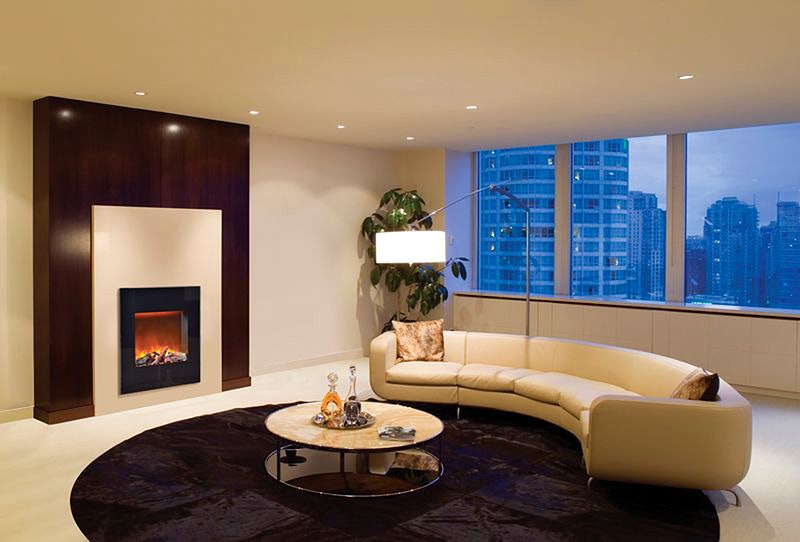There are many different types of fireplaces. From traditional to gas or electric, or even the more recent resurgence in wood burning stoves, homeowners have plenty of options nowadays and one currently gaining traction is the prefabricated, or zero-clearance fireplace. As the name suggests, they are fireplaces where no clearance space is required.
If you’re considering a zero-clearance fireplace, or other options in general, then we’ll help you consider what they are, the pros and cons, and the forms they take.
Table of Contents
What is a Prefabricated Zero-Clearance Fireplace?
What is a Zero-Clearance fireplace?
A zero clearance fireplace is a pre-made fireplace made designed in a manner that only the glass at the front allows heat to escape. No heat escapes from the back or sides.
Because of the materials they are made from, which provide fantastic insulation, they can be put anywhere in the home. You won’t have to worry about having your house set on fire.
Many people even choose to put them inside their walls, so the fireplace takes up as little room as possible. However, they still benefit from looking at a fire and enjoying its warmth.
Because it’s zero clearance, people who have this kind of fireplace in their walls do not need to worry about the bricks burning over time. The only place where you can feel the heat is from the glass, where you can see the fire.
But, even if it’s not inside the wall, you could put flammable objects such as books next to it without being a safety hazard.
Benefits of a Zero-Clearance Fireplace
As we’ve just spoken about, the first and most obvious benefit of having a prefabricated fireplace is that there is less chance of a fire. In the USA, there were 48,530 fires caused by heating equipment between 2014 and 2018. Prefabricated fireplaces are responsible for almost zero housefires.
They also take up less space. When installing a traditional fireplace, you need to first ensure it’s big enough to heat the whole room. But secondly, you need to make sure there is good airflow and it’s away from flammable materials. With a prefabricated fireplace, so long as there is enough space to physically put it in the room, there is enough space.
Installation of the fireplace is much quicker. You do not need to shield it from walls, carpenters, or other materials. You essentially just have to put it there. This installation can usually be one in a day or two.
And finally, it’s more efficient. Because heat is only coming from one part (the front), you don’t need to worry about heat escaping into the walls or outside the house. Up to 70% of the heat they generate will go directly out the front to keep you warm.
Disadvantages of of Zero-Clearance Fireplaces
As great as prefabricated fireplaces can be, there are also some disadvantages.
If you pick the wrong one, it can look cheap and tacky. I’ve seen plenty of fireplaces that look like something from Ikea and make your room feel like something out of a budget hotel room, not a family home.
If you like fireplaces with a lovely old fashioned look to them, be very careful about zero-clearance fireplaces. Many of them look too modern for particular tastes.
Types of Zero-Clearance Fireplaces
Wood Burning
A wood zero-clearance fireplace works similarly to a wood-burning stove. It requires a regular supply of dry wood to operate.
The fire inside this kind of fireplace is kept alive by air outside the house.
Some people opt for a wood-burning prefabricated fireplace because it very closely resembles the appearance of a traditional fire. You can sit by the fire and watch the wood burn away.
Gas
Many people opt for gas-powered fires these days. The helpful thing about these fireplaces is that they can usually be turned on with the flip of a switch. You don’t need to constantly refuel them with new wood or coal. You just turn them on.
Most gas fireplaces will use the same gas that the rest of your house uses- in the boiler and the gas cooker. This gas will usually be either natural gas or propane.
Some of you might see some gas fireplaces with logs inside. But these logs are just there for effect. They are made of non-combustible materials and give the illusion of a wood-burning fire.
Electric
The final type of zero-clearance fireplace is electric.
Even if they generate a bit of heat, it’s doubtful that electric fireplaces will be the primary heat source for your home.
If you want to express your creativity, however, they are ideal. They can have various colors and patterns inside them. I’ve seen some with pink stones inside.
As the name “electric” would suggest, their power comes from electricity.
Zero-Clearance vs Insert Fireplace
One type of fireplace that often gets confused with “zero clearance” is the fireplace insert. Although many fireplace inserts happen to be zero clearance, they are not the same thing.
A fireplace insert is a fireproof box specifically designed to go into an existing fireplace. A regular zero-clearance fireplace can go anywhere, even if you do not live in a house that contains an original fireplace space.
For that reason, zero-clearance fireplaces are most commonly found in new homes. But fireplace inserts are more commonly found in older homes.
Zero-Clearance Fireplace Framing
It may look like your zero clearance fireplace is made from brick or some other kind of masonry from the outside. But that’s just a cover designed purely for aesthetic/style reasons.
In reality, most zero-clearance fireplaces are made from thick steel. The metallic properties of the steel enable the box to get retain a huge amoutn of heat, which helps heat up your home. But, the thickness prevents that heat from escaping through the sides or the back. Heat is trapped and only comes out at the front to keep the room warm.
Zero-Clearance Fireplace Installation
To install most zero-clearance fireplaces, you will need a hole in the wall or ceiling for gas to escape. This can be done via the already built chimney in some homes, but in more modern homes, this hole needs to be put in specifically for the fireplace.
After all, the waste gases do need to escape somewhere.
Usually, installation is as simple as attaching the centre section (inner pipes) into place and locking the over section (outer pipes) on top. The final pipe will be curved if your hole is on the wall. You will probably need multiple levels of pipe until they reach the hole.
Not all zero-clearance fireplaces use visible pipes. Some newer models, primarily those in-built into a wall or feature pillar, are hidden from view within the room.
–
We hope this helps in your understanding of what zero-clearance fireplaces are, the pros and cons, and other considerations around them.
For everything else home heating, stick with CosyWarmer.com

